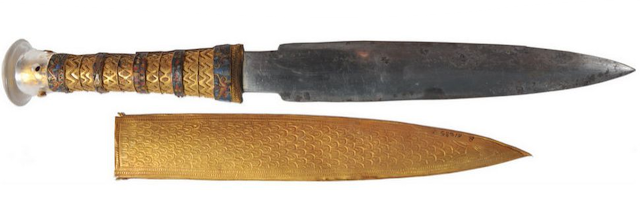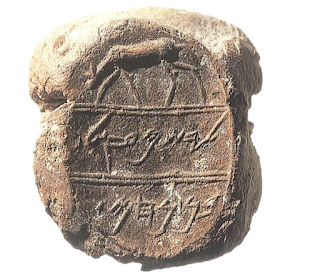This week’s Come Follow Me lesson focuses on 1 Nephi 1–7 in the Book of Mormon, which tells the story of Lehi’s call as a prophet in Jerusalem, the people’s rejection of his message, his flight with his family into the wilderness, establishing camp in a river-valley along the coast of the Red Sea, and his sons two return trips back to Jerusalem—first to get the plates of brass from Laban, and then to recruit Ishmael and his family to join them.
To go along with your reading this week, I thought it would be fun to highlight seven archaeological discoveries related to these chapters in the Book of Mormon. I do not present them as evidence for the Book of Mormon, per se, but rather as a few simple and straightforward examples of how archaeological discoveries can enrich our study of ancient scripture, including the Book of Mormon. While these do not yield major insights into the early setting of the Book of Mormon, they do help us see how some details in the Book of Mormon connect to the ancient world.
1. The Jerusalem Chronicle (1 Nephi 1:4)
The story of Lehi and his family begins in the “first year of the reign of Zedekiah, king of Judah” (1 Nephi 1:4). According to the Bible, Zedekiah’s reign began when King Nebuchadnezzar of Babylon came along, laid siege to Jerusalem, and replaced King Jehoiachin with Zedekiah (2 Kings 24:9–17; 2 Chronicles 36:9–10). Babylonian chronicles discovered in the late-19th century confirmed this detail of the Biblical narrative, recording that in the seventh year of his reign, Nebuchadnezzar laid siege to “the city of Judah,” and on the date of Adar 2nd, “took the city and captured the king” and replaced him with “a king of his choice.” The tablet that discusses this is commonly called “the Jerusalem Chronicle.”
Scholars are able to correlate Adar 2nd in the seventh year of Nebuchadnezzar to March 16, 597 BC. Since Lehi’s story begins in the first year of the reign of Zedekiah, this archaeological evidence (combined with some additional factors) allows us to generally date the events of 1 Nephi 1–2 to ca. 597–595 BC.
2. Wadi Tayyib al-Ism (1 Nephi 2:6–10)
When Lehi flees into the wilderness, he leads his family down to the Red Sea, and the journeys for another three days before setting up camp in a valley with a running river near the Red Sea coast (1 Nephi 2:6–10). He names the valley after his son Lemuel and the river after his son Laman. Several different routes have been proposed for Lehi’s journey from Jerusalem to the Red Sea, but all them lead to the northern tip of the Gulf of Aqaba. Warren Aston’s latest article in BYU Studies, “Into Arabia: Lehi and Sariah’s Escape from Jerusalem” provides a useful summary (and critique) of the various proposals before adding a new suggestion to the mix. If you download the PDF, p. 104 has a map that helpfully shows all the various proposals.
From the northern tip of Aqaba, only one valley has ever been found that generally fits with Nephi’s description of the Valley of Lemuel: Wadi Tayyib al-Ism. First discovered and reported by George Potter in the mid-1990s, Aston’s new paper also reports new fieldwork done at Wadi Tayyib al-Ism and the surrounding area. Aston’s explorations confirm that Wadi Tayyib al-Ism is the only valley along the coast of the Red Sea with a perennially flowing river or steam, and addresses the main objections some have raised to the correlation with the Valley of Lemuel.
Of particular interest is Aston’s documentation of the present-day stream reaching much closer to the sea than previously believed—on p. 121 of the PDF he shows a picture of the stream extending to within 42 m. (ca. 46 yards) of the sea, whereas previous reports stated the stream ended hundreds of meters from the sea, leading some to doubt whether the mouth of the river/stream could have ever reached the Red Sea in antiquity. Documentation of the steams flow reaching so close to the sea in modern times (when it’s been significantly diminished by modern water pumps drawing water away to more populated areas) suggests that it is very likely it actually reached the sea in the past, when it was larger and more like a river.
Placing Lehi’s encampment in Wadi Tayyib al-Ism brings to life Lehi’s poetic imagery in 1 Nephi 2:9–10, and the uniqueness of this valley from the surrounding region helps us appreciate how the Lord guided Lehi to an important haven for refuge as his family prepared for the much longer, grueling journey through the rest of Arabia.
3. “Land of Jerusalem” in the Dead Sea Scrolls and Amarna Letters (1 Nephi 3:9–10)
When Nephi and his brothers are sent back to get the plates of brass from Laban, he says they went up to the “land of Jerusalem” (1 Nephi 3:9–10), a phrase that occurs several other times in Nephi’s writings, and also when later Book of Mormon writers talk about their ancestral homeland. Jerusalem was only known as a city in the Bible, but several archaeological discoveries provide confirming evidence that it was a “land” as well during biblical times.
First, in the late 19th century, the Amarna Letters were discovered in Egypt. Several of these letters from the 14th century BC use the phrase “land of Jerusalem.” Later, when the Dead Sea Scrolls were found, a 1st century BC fragment used the phrase “land of Jerusalem.” What’s interesting about this Dead Sea Scroll fragment is it occurs in a story about Jeremiah, Lehi’s contemporary, and a pair of scholars analyzing it thought that this phrase enhanced the story’s “sense of historicity” because of how accurately that phrase captures the political and administrative situation in early 6th century BC.
Lastly, archaeology has uncovered many sites that were flourishing in Jerusalem’s “hinterland” ca. 7th–6th century BC, along with evidence of an administrative apparatus demonstrating that Jerusalem was the center of a “district” or “land.” This evidence gives us a pretty a good idea of what the geographical range and extent of the “land of Jerusalem” would have been in Lehi’s day (ca. 5–7 miles from the city).
4. Steel Swords (1 Nephi 4:9)
When Nephi finds Laban passed out in the streets of Jerusalem late at night, he draws his sword and admires it’s craftsmanship. He notes that the “hilt thereof was of pure gold” and “the blade thereof was of the most precious steel” (1 Nephi 4:9). Nephi’s description of Laban’s sword is strikingly similar to how Howard Carter described King Tutankhamun’s dagger, which he found among the treasures of Tutankhamun’s tomb in 1922. Carter said: “The haft of the dagger is of granulated gold … but the astonishing and unique feature of this weapon is that the blade is of iron, still bright and resembling steel!”
Another sword was discovered closer to Laban’s time and place in the 1980s. Known as the Vered Jericho Sword, it was found in a fort a short distance from Jericho and dated to the late-7th century BC. Metallurgical analysis of the blade found that the iron had been hardened into “mild steel” by an expert metalsmith. From these discoveries, we gain gain an idea of what Laban’s sword might have been like. They also allow us to join with Nephi in appreciating the fine craftsmanship that went into making a weapon of that nature.
5. The Name Sariah (1 Nephi 5:1–9)
Nephi’s mother Sariah worried about her sons when they were gone longer than expected trying to get the plates of brass from Laban. When they returned, however, she rejoiced and praised the Lord, gaining a sure testimony that the Lord was in command and would protect those who followed his commandments (1 Nephi 5:1–9). The Hebrew name Sariah (ŚRYH), more often spelled Sereiah, was very popular as a male name in Judah around the 7th century BC.
Two archaeological discoveries from the Jewish community in Elephantine—a papyrus listing the names of financial donors to the temple of YHW (Jehovah), and a pottery shard with a names list inscribed on it, both dated to the 5th century BC—provide evidence that the Hebrew name SRYH was also a female name in antiquity. Interestingly, the community at Elephantine originated in the 7th century BC and had ties back to the northern kingdom of Israel, just like Lehi and his family.
Since, as I mentioned, Sariah gains a testimony that the Lord was in command in this story, it is interesting that the Hebrew name Sariah most likely means “the Lord is my commander/prince.” (An insight I gained from Taylor Halverson’s Scriptural Insights and Commentary: the Book of Mormon.)
6. The Silver Scrolls of Ketef Himnon (1 Nephi 6:3)
Nephi completes his story about gaining the brass plates by describing his father, Lehi, dutifully studying the contents of those plates and finding much of the Hebrew Bible and other (now lost) prophetic writings on them (1 Nephi 5:10–16). Nephi then provides a brief note about the record he was writing, explaining that upon “these plates” of precious metal, he intends to “write the things of God” (1 Nephi 6:3).
Many examples of writing on metal in the ancient world have been discovered. Among the most interesting for understanding Lehi’s world is a pair of small silver amulets, discovered just outside of Jerusalem and dated to ca. 7th–6th century BC. On these amulets are written biblical passages, such as the high priestly blessing in Numbers 6:24–26. The form and purpose (and magnitude) of such writing was different from that of Nephi’s, but evidently others in Lehi’s time also wrote “the things of God” on precious metals.
7. The Name Ishmael (1 Nephi 7:2)
After Lehi prophesied about his future seed (1 Nephi 5:19), he must have started pondering how such prophecies would be fulfilled given that none of his sons were married. As a result, he soon received another revelation for his sons to go back and “bring down Ishmael and his family” (1 Nephi 7:2). Ishmael had enough daughters for all his sons to marry.
The name Ishmael is, of course, well known from the Bible (see Genesis 16–17, 25; 2 Kings 25). Still, it is interesting to note that 60 different archaeological sources from around the 7th–6th century BC attest to the name Ishmael, leading scholars to believe that this name was pretty popular in Lehi’s day. Most of these sources are Hebrew seals that would have been used to seal documents.
Could one of the Ishmaels attested in these seals be the Book of Mormon man named Ishmael? Perhaps, but we don’t have enough information to really know. Given how common the name shows up, though, it comes as no surprise that the Book of Mormon talks about an Ishmael living in Jerusalem at this time. And since we know from this archaeological evidence that Ishmael was a popular name, this confirms what many Book of Mormon scholars have long supposed: that Lehi must have already known who Ishmael was, since he apparently knew exactly who the Lord meant by “Ishmael” without further clarification.
As a fun side note—and I stress that this really is nothing more than a fun detail which proves nothing—the example seal pictured here reads “Ishmael son of Nahum.” Five other seals also document an “Ishmael son of Nahum,” making Nahum one of the more common names to appear alongside “Ishmael” in the Hebrew seals. Although I doubt there is any connection to the Book of Mormon Ishmael, who died and was buried at Nahom (see 1 Nephi 16:34), it is kind of fun to see the name Ishmael frequently alongside an NHM name in the archaeological record.
Closing Remarks
Continue reading at the original source →











